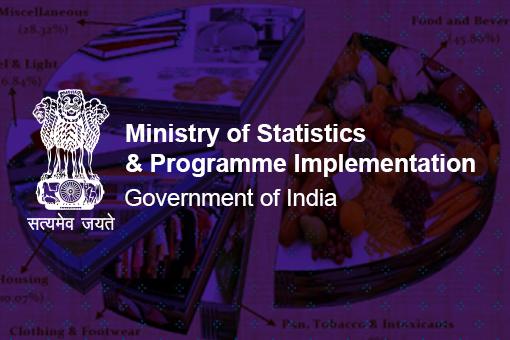NSS REPORT NO. 587: Situation Assessment of Agricultural Households and Land and Livestock Holdings of Households in Rural India, 2019 (JANUARY – DECMEBER 2019)

- Background
1.1 National Statistical Office (NSO) in its 77th round of survey, conducted during the period 1st January 2019 to 31st December 2019, carried out a survey on “Land and Livestock Holdings of Households and Situation Assessment of Agricultural Households” in the rural areas of India with an integrated schedule of enquiry. Prior to 77th round, Land and Livestock Holding Surveys (LHS) and Situation Assessment Survey (SAS) of Agricultural Households used to be conducted as separate surveys in separate sets of households.
- Objective of the Survey
2.1 The integrated survey on Land and Livestock holdings of Households and Situation Assessment of Agricultural Households, conducted in the rural areas of the country, had an objective of generating different indicators like:
- ownership and operational holdings of rural households
- ownership of livestock
- income, productive assets and indebtedness of agricultural households
- farming practices of agricultural households
- awareness and access to various technological developments in the field of agriculture
- receipts and expenditure of the agricultural households’ farm and non-farm businesses and receipts from all other economic activities pursued by the members of the agricultural households
3 Collection of information
3.1 The information was collected in two visits from the same set of sample households in rural areas with a view to collect relevant information separately for the two halves of the agricultural year July 2018 – June 2019. The first visit was made during January -August 2019 and the second was during September- December 2019.
4 Agricultural household
4.1 An agricultural household for NSS 77thRound survey was defined as a household receiving more than Rs. 4000/- as value of produce from agricultural activities (e.g., cultivation of field crops, horticultural crops, fodder crops, plantation, animal husbandry, poultry, fishery, piggery, bee-keeping, vermiculture, sericulture, etc.) and having at least one member self-employed in agriculture either in the principal status or in subsidiary status during last 365 days. Like in previous rounds, households which were entirely agricultural labour households and households receiving income entirely from coastal fishing, activity of rural artisans and agricultural services were not considered as agricultural households and they were kept outside the scope of the survey.
5 Sample size
| FSU/Households/persons | Visit 1 | Visit 2 |
| FSU allotted | 5950 | |
| FSU surveyed | 5,940 | 5,894 |
| households surveyed | 58,035 | 56,894 |
| Agricultural households surveyed | 45,714 | 44,770 |
6 Important results
It may be noted that all the estimates relate to the rural areas of India.
6.1 Percentage distribution of agricultural households and non-agricultural households
| Table 1: Percentage distribution of agricultural households and non-agricultural households by social group in rural areas of India for the agricultural year July 2018- June 2019 | |||
| social group | agricultural households | non-agricultural households | rural households |
| ST | 14.2 | 10.0 | 12.3 |
| SC | 15.9 | 28.4 | 21.6 |
| OBC | 45.8 | 42.8 | 44.4 |
| others | 24.1 | 18.8 | 21.7 |
| All | 100.0 | 100.0 | 100.0 |
6.2 Percentage distribution of agricultural households and non-agricultural households by size class of land possessed
| Table 2: Percentage distribution of agricultural and non-agricultural households by size class of land possessed (ha.) for the agricultural year July 2018 – June 2019 | |||
| size class of land possessed (ha.) | agricultural households | non-agricultural households | rural households |
| < 0.01 | 0.6 | 26.8 | 12.7 |
| 0.01 – 0.40 | 34.2 | 69.0 | 50.2 |
| 0.40 – 1.00 | 35.6 | 3.1 | 20.6 |
| 1.01 – 2.00 | 17.7 | 0.7 | 9.9 |
| 2.01 – 4.00 | 8.6 | 0.4 | 4.8 |
| 4.01 – 10.00 | 2.8 | 0.0 | 1.5 |
| 10.00 + | 0.4 | 0.0 | 0.2 |
| all sizes | 100.0 | 100.0 | 100.0 |
6.3 Household Ownership Holdings of Land
Land, with permanent heritable possession, with or without right to transfer the title, was considered as owned land. The land held in owner-like possession under a long-term lease or assignment (e.g., village land possessed by a tribal household as per traditional tribal rights or community land customarily operated by a tenant for a long period) was also treated as land owned.
6.3.1 Size of ownership holdings
| Table 3: Average size of household ownership holdings and percentage of landless households during 2019 | |
| average area (ha.) owned per household | 0.512 |
| percentage of landless households | 8.2 |
| average area (ha.) owned per household excluding landless households | 0.558 |
| Households with no land or with ownership holdings of area less than or equal to 0.002 ha. are considered as ‘landless’ | |
6.4 Household Operational Holdings
6.4.1 Household operational holding has been defined as land that was used wholly or partly for agricultural production and was operated (directed/managed) by one household member alone or with assistance of others, without regard to title, size or location. Within a household, multiple operational holdings were not distinguished. The land might be operated by members belonging to a single household or by members belonging to more than one household operating jointly. However, holdings operated as cooperative farms were not considered as household operational holding in this survey. A household growing vegetable in the kitchen garden or flowers in the courtyard or raising livestock & poultry or carrying out pisciculture was considered to operate a holding, even if no crop production was undertaken by it during the reference period.
Area of operational holding: Operational holding encompasses all land – owned, leased in or otherwise possessed with the condition that some agricultural activity was carried out on any part of the land under its possession during the reference period.
Area operated:Only the area used for agricultural activities in the operational holding in a reference period is termed as area operated.
6.4.2 Area of operational holdings
| Table 4: Estimated number of operational holdings, averaged area of operational holding and average area operated per operational holding | |||
| Indicator | Jul 18 – Dec 18 | Jan 19 – Jun 19 | Jul 18 – Jun 19 |
| number of operational holdings (million) | 103.454 | 85.913 | 101.982 |
| average area per operational holding (ha.) | 0.902 | 0.880 | 0.913 |
| average area operated per holding (ha.) | 0.815 | 0.682 | 0.833 |
6.5Crop Production
6.5.1 Twenty-Five selected crops were identified to present crop-wise estimates in the report. These are: Paddy, Jowar, Bajra, Maize, Ragi, Wheat, Barley, Gram, Arhar (Tur), Urad, Moong, Masur (Lentil), Sugarcane, Potato, Onion, Groundnut, Sesamum, Rapseed/Mustard, Coconut, Sunflower seed, Safflower, Soyabean, Nigerseed, Cotton, Jute. However, crop-wise estimates is presented in respect of those selected crops which were reported by at least 1 percent of the surveyed agricultural households at all India level separately for the two halves of the agricultural year.
6.5.2 Percentage of households producing crop
| Table 5: Average gross cropped area, harvested quantity produced and value for agricultural households reporting production of selected crops | |||||
| Crop | percentage of agricultural households reporting production of crops | percentage of crop producing agricultural households reporting sale of the crop | average per agricultural household reporting production of crops | ||
| gross cropped area (0.000 ha.) | harvested quantity produced (kg./no.)# | value of (Rs.)total production* | |||
| July 2018- December 2018 | |||||
| Paddy | 53.2 | 52.6 | 0.617 | 2,035 | 36,139 |
| Jowar | 3.5 | 48.1 | 0.713 | 677 | 15,420 |
| Bajra | 8.3 | 48.6 | 0.769 | 672 | 12,692 |
| Maize | 11.3 | 47.1 | 0.467 | 815 | 13,671 |
| Ragi | 1.6 | 36.3 | 0.398 | 336 | 9,154 |
| arhar(tur) | 2.9 | 60.4 | 0.684 | 388 | 18,953 |
| Urad | 4.1 | 50.5 | 0.568 | 264 | 9,860 |
| Moong | 2.7 | 44.8 | 0.667 | 216 | 10,973 |
| Sugarcane | 3.5 | 95.9 | 0.608 | 37,474 | 1,01,625 |
| Potato | 1.4 | 48.5 | 0.111 | 1143 | 9,240 |
| Groundnut | 2.1 | 77.6 | 0.810 | 737 | 31,859 |
| Coconut | 2.0 | 61.2 | 0.185 | 1,227 | 15,109 |
| Soyabean | 6.0 | 94.4 | 1.175 | 1,202 | 37,584 |
| Cotton | 7.2 | 94.6 | 1.108 | 1,209 | 62,291 |
| all crops | 92.7 | xxx | 0.889 | xxx | 46,277 |
| January 2019- June 2019 | |||||
| paddy | 9.3 | 76.6 | 0.606 | 2,755 | 45,866 |
| jowar | 1.8 | 60.1 | 0.861 | 1,233 | 32,064 |
| maize | 3.5 | 82.0 | 0.458 | 2,014 | 34,419 |
| wheat | 41.2 | 50.8 | 0.630 | 1,948 | 37,657 |
| gram | 6.7 | 63.2 | 0.625 | 584 | 23,891 |
| arhar(tur) | 1.7 | 51.9 | 0.418 | 311 | 15,203 |
| moong | 1.5 | 51.1 | 0.429 | 191 | 9,608 |
| masur | 2.1 | 47.8 | 0.271 | 233 | 9,952 |
| sugarcane | 2.4 | 95.7 | 0.600 | 34,774 | 1,05,189 |
| potato | 5.3 | 55.0 | 0.160 | 2,933 | 17,270 |
| onion | 1.3 | 55.6 | 0.272 | 3,873 | 31,255 |
| rapeseed/mustard | 7.5 | 45.2 | 0.402 | 601 | 22,584 |
| coconut | 1.9 | 56.4 | 0.175 | 880 | 10,468 |
| cotton | 1.3 | 90.7 | 1.137 | 963 | 48,298 |
| all crops | 72.5 | xxx | 0.775 | xxx | 50,807 |
| * Total value of production includes value of harvested crop, pre-harvest sale and value of by-products. #for all crops except coconut, harvested quantity is reported in kg and for coconut harvested quantity is reported in numbers. | |||||
6.6Average Monthly Income per Agricultural Household
6.6.1 The survey collected information on the receipts and expenditure relating tocropproduction, farming of animals and non-farm business, separately for the two halves of the agricultural year July 2018 – June 2019. Income from wage/salary employment and income from leasing out of land were also recorded for the same period. Based on this information, average monthly income per agricultural household has been worked out for the agricultural year July 2018 – June 2019 by adding up income from wages/salary, income from leasing out of land, net receipt from crop production, farming of animals and non-farm business. Net receipt is worked out by deducting total expenses from total receipts for each source of income.
| Table 6: Average monthly income (Rs) from different sources per agricultural household during July 2018 – June 2019 | ||||||
| approach | components of income | |||||
| income from wages | income from leasing out of land
| net receipt from crop production | net receipt from farming of animals | net receipt from non-farm business | Total income
| |
| paid out expenses approach | 4,063 | 134 | 3,798 | 1,582 | 641 | 10,218 |
| both the paid out expenses and imputed expenses | 4,063 | 134 | 3,058 | 441 | 641 | 8,337 |
6.7 Indebtedness of Agricultural Households
Information on the amount of outstanding loan as on date of survey (i.e., the day on which data was collected from the household) was collected from each of the surveyed agricultural households during the first visit.
| Table 7: Percentage of indebted agricultural households and average amount (Rs.) of outstanding loans per agricultural household
| |
| indicator | value |
| percentage of indebted agricultural households | 50.2% |
| average amount (Rs.) of outstanding loan per agricultural household | Rs. 74,121 |



